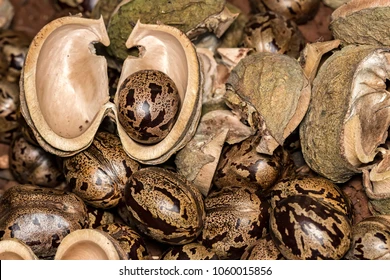by: Lumad Aloranon
 This must be the most popular toy both boys and girls enjoy playing.
This must be the most popular toy both boys and girls enjoy playing.Rubber tree according to some agrix guys I spoke to, are abundant in places like Maular, Lumbayao, Mitazan and probably other Aloran Baranggays too.
An average-size tree stands like the varieties of mangoes we grow now, with less branches and leaves.
The fruit, in a pouch the size of a big lanzones.
Green when raw, brown when ripe.
The outer skin is like of that of lanzones, the next layer is a hard shell, in it are the beans, the singgam we walk miles and miles in search-of.
Pouches can contain four to six of these gems.
Inside this gems is white meat, the taste is not great but edible.
Classification
Singgam (a mass noun) are classed according to its appearance, size and origin.
Maular
To my knowledge, found only in Maular.
It is the biggest and heaviest of them all.
It is oval and comes in glossy blackishyellowish.
Kapayason
Longer than Maular but less wide.
Some can be as heavy as Maular.
They come in black with a few yellow sprinkle.
Amerkano
It is big, wide and red, hence the name.
Iyonay
Tiny, turtle-like.
Hunch back, flat belly, comes in gray, black and blue.
Buktot
The smallest of them all.
Hunch back, regular belly, comes in blue and gray.
Unclassified
Unlike any of the above.
The Games
Taksi
A two-player minimum game, the more the merrier.
Draw a circle on the ground.
Agree on the quantity of singgam each player puts on the pot.
Lump them in the center of the circle, leaving one (puntarya) front.
Draw a straight line, say ten feet from the circle (manuhan).
Each player throws his batuan to the line.
The closest, takes the first shot.
From the manuhan, hit either the puntarya or the lump.
No hit, the next guy takes a shot.
If one and only one is taken out of the circle, you have the booty, ready for another game.
If not, that is pago, lump them back again for the next guy to take a shot.
In this game, the weight of your batuan matters.
One genius came up with an innovative solution, Tiningga-an, with lead.
Choose the biggest one you have–usually a Maular.
Gently remove the sungo for later-use.
Put it (singgam) in a fixed-position on its back.
Gently bore hole where the sungo was removed-from.
Take its meat out with a pointed object.
For complete removal, place it where ants can feast on its meat.
Replace removed-meat with tingga, hence tininggaan, and stick the sungo back with honey from kiyot.
When you hear someone says your baby is tiningga-an, that means, heavy.
Siki
It is typically played in living rooms.
My cousins and I used to play this in our grandmother's place.
Players sit on the floor, forming a circle.
Each player hands a talibi to the dicer, (each player gets to be the dicer).
The dicer throws them on the floor and say either kub (on its belly) or hayang (on its back).
The first talibi that gets the dice, starts the game, and so on.
The choice of talibi here is important.
Take iyonay for example, it has the tendency to hit the floor on its belly and in the case of buktot, landing on its belly or back is less-predictable.
Put away your talibi.
Put all singgam (quantity from each player is agreed-upon pre-game) in your palm and throw them on the floor.
Look for a pair.
A pair should pass siklot.
When a pair appears to be too close to each other, the player is required to pass his/her smallest finger in-between, touching neither.
This is where my girl-cousins have the advantage.
Not only that their smallest finger is smaller than the boys' they also have long nails (picking their nose was not the only use of their long nails).
You then litik one to hit the other.
You make it, you have both.
Keep going until none is left or you miss.
Another cousin who now lives in Maryland has a good collection of singgam.
She is inviting Aloranons to come-by anytime for a siki og singgam marathon.
If I live the day Aloran accepts nomination for its Hall of Fame, Sports, Singgam category, I will work hard for her.